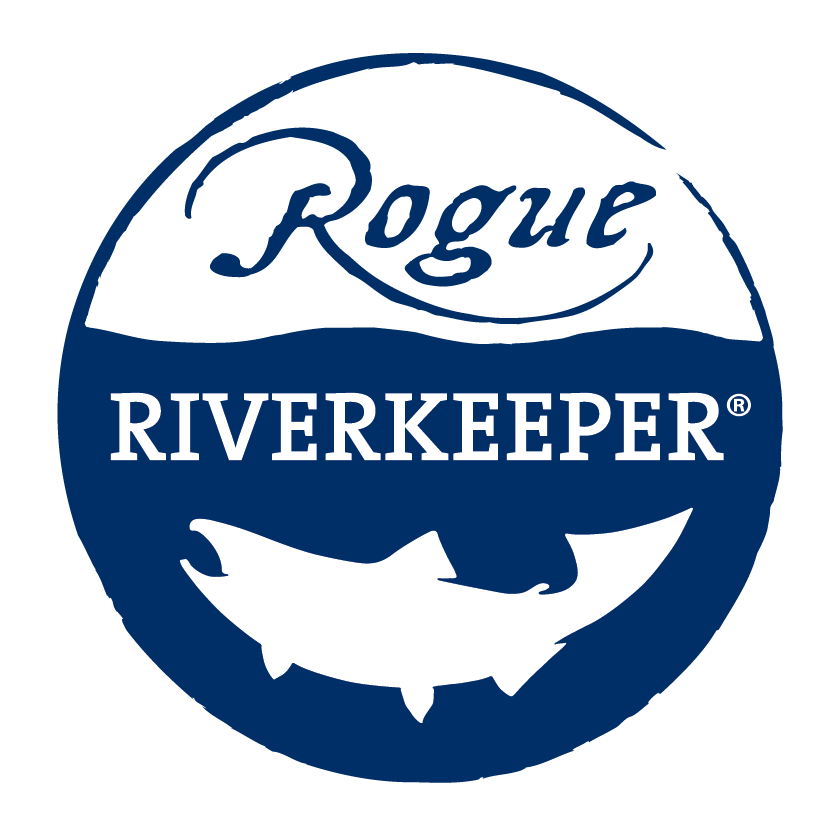There must be something in the water (is it E. coli?)
Kathryn Connelly, Rogue Riverkeeper’s water quality monitoring technician, collects a water sample from Bear Creek at North Mountain Park in Ashland. Haleigh Martin photo
Every summer, many of us head to the lakes, rivers and creeks around the region to find a reprieve from the Southern Oregon heat. If you don’t get there early, places like Lost Creek Lake or Emigrant Reservoir, swimming holes along the Rogue River or the beach at Cantrall Buckley on the Applegate River will be full. We are fortunate to have ample access to so many water sources across the region, but does that mean every swimming spot is safe to jump into?
As air temperatures rise throughout the summer, agricultural irrigation returns enter waterways, and the cold clean inputs from tributaries and groundwater decline, causing stream and lake temperatures to increase, which can raise bacteria levels that can make people and pets sick. Each summer, Rogue Riverkeeper keeps its finger on the pulse of the Rogue basin’s water quality through its Water Quality Monitoring Program so we can let the public know where it is safe to recreate. We send staff and volunteers out to popular swimming holes to take samples to test in our lab for E. coli, a common bacteria that can lead to gastrointestinal illness for people and pets. These results are then posted on the Swim Guide for all to see for free.
Recently in our water quality monitoring, a few sites in the Rogue basin failed for safe water contact: Bear Creek at Bear Creek Park in Medford, Little Butte Creek in Eagle Point and Wagner Creek in Talent. When viewing the Swim Guide, you can see if there have been past samples that have failed or if the location consistently is safe for water contact.
Here is a breakdown of what that means and how to avoid waterborne illness while swimming this summer:
E. coli bacteria can cause gastrointestinal illnesses. National Institutes of Health image
What does a failing test mean?
When Rogue Riverkeeper monitors for the Swim Guide, we are testing for the presence of E. coli, a type of naturally occurring bacteria that lives in the intestines of warm-blooded animals. Its presence indicates the presence of pathogens that can make people and pets sick.
We compare our results to the Oregon recreational water quality standard set by the Department of Environmental Quality. A failing test indicates that the body of water from which the sample was taken is not safe for water contact through activities like swimming, boating or fishing for humans or pets.
What can cause a site to fail?
Bacteria in a body of water are extremely variable. In any single natural water body at one time, different occurrences of bacteria will vary based on physical and biological factors. There are numerous reasons why a site might contain high levels of E. coli and produce a failing test result. Common sources of E. coli include overflowing septic fields and sewage systems, as well as fecal matter from any warm-blooded animal, including livestock, wildlife and pets. The matter can enter streams through runoff or stormwater systems. During the summer in our region, irrigation water frequently returns to waterways after it has been contaminated by flowing over fields and pastures. This practice is legal. However, used irrigation water can have high levels of bacteria.
Kathryn Connelly, Rogue Riverkeeper’s water quality monitoring technician, holds up a sample taken from the Rogue River at the Gold Hill Family Beach Park. Kathryn Connelly photo
When is a failing site safe to recreate in again?
After a site has failed for unsafe water contact due to high levels of E. coli, it is important that the waterway is not used for recreation again until a passing test result has been published. After a site fails to pass, we test the site again at the exact location a week later, We publish that information on the Swim Guide for you to review.
What else can make a waterway unsafe for recreation?
There is always the potential for other types of hazards from swimming in natural water, such as “swimmer’s itch” or harmful algal blooms, which we do not test for in our sampling. Additionally, there is no way to determine if water is safe for drinking or swimming based only on how it looks. You can click the links above to learn more about these two additional open water risks.
We choose our sample sites based on locations with a high likelihood of people coming into contact with the water through swimming, boating or other water activities in order to keep you and your loved ones safe from open-water risks during the summer swimming months. There is no public agency that samples these waterways with the frequency that Rogue Riverkeeper does, and we are happy to provide our community with this resource.




